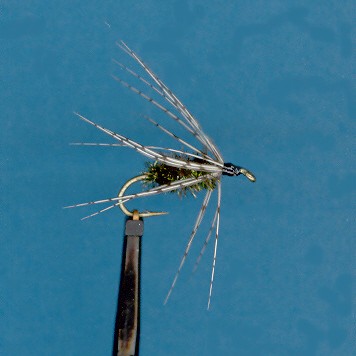
On The Fly
"Fly tying is a school from which we never graduate"
TYING NEWSThe Southern Oregon Fly Tiers met Wednesday, October 12th at the library in Gold Hill. There was a fly raffle, a fly exchange and tying demonstrations. We had two new tiers drop by for a fun evening. A lot of valuable knowledge was exchanged at no-charge. Please join us the second Wednesday of each month for more fun and the sharing of the art.
 PATTERN OF THE MONTH - Sly's Midge
PATTERN OF THE MONTH - Sly's Midge
Hook Standard or 1X short, size 16-18.
Thread Black, 8/0.
Body Peacock herl.
Hackle Gray Partridge, 1 turn.
Tying Instructions:
1) Start the thread at a position on the hook shank that allows the proper room for the head. Use this
as a marker and donít tie anything past this mark. Wrap a thread base back to a position just above the
hook barb.
2) Tie in a Peacock herl at this point, advance the thread and wind the herl forward and tie it off.
3) Tie in the Partridge hackle, make one turn, then tie it off.
4) Form a neat small head, whip finish, and cement.
With the winter months ahead of us, many fly fishers are counting down the days until they can get out and wet a line again, while others are fishing the one bug that hatches year round, the mighty midge. Midges are an abundant source of food giving trout thousands of opportunities to feed. Even in sub-freezing temperatures midges often hatch in the warm microlayer of air just above the waterís surface.
Pursuing trout in the wintertime is a unique experience filled with its own challenges. The cold wind and icy water can numb fingers to the point where knot tying can seem almost impossible. Trout behave differently in the frigid waters, shifting to slower pools and seeking protection in the depths, near logs, or undercuts. They become reluctant to move far for a meal and when hooked are less inclined to jump choosing instead to hold deep and shake their heads. Your fishing tactics should slow too. The best results will come from keeping things small, discrete, and at a snails pace.
Your fly selection should consist of size 16 or smaller and include midge patterns to imitate all four stages of development. Having some flies weighted with small glass bead heads, will keep them down at the level of the fish.
This monthís pattern, Slyís Midge, imitates the emerging stage and is fished in the film just below the surface. The fly was originated by Sylvester Nemes from Bozeman, Montana, and is one of his many soft-hackle patterns. Sylvester is largely responsible for the popularity of this sparsely dressed style of fly in North America via his three books on the subject.
This very effective winter pattern is an easy tie, with only two parts: the body and a hackle. Peacock is always deadly, but the body material and color can be substituted for a match. Try some soft hen feather or grouse for the hackle. Tie some up, bundle up, and give them a good test flight. Let me know how you do.
TYING TIPS - Hard-to-find feathers
It is difficult to find partridge feathers small enough for these winter-size
soft-hackle patterns in size 16 or smaller. Therefore, it is advisable to tie the hackle tip to the hook
instead of tying the hackle stem to the hook. The barbules near the tip are shorter and the stem is more
pliable for winding.
Tie One On,
Dan Kellogg
(you can contact me at FLYGUY@EZNORTHWEST.COM)